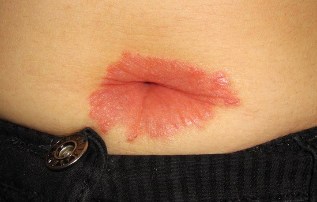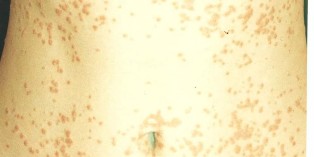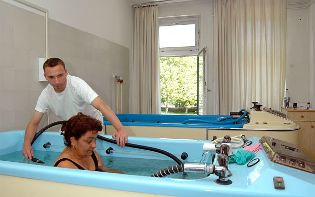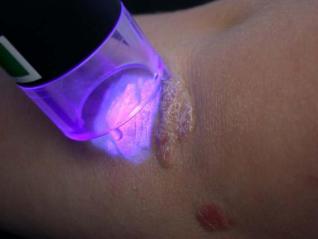Psoriasis refers to dermatoses and manifests itself in unpleasant rashes on the body. That almost does not hurt, but severe itching and unsightly appearance, therefore, expresses man a lot of inconvenience. Let's see what are the types of psoriasis that differ and how you can cure the disease .
Classification of psoriasis ICD-10

According to the international classification of diseases psoriasis is assigned a code L40. This means that it refers to the papuloscentus violations (from lat. papule - the "node" and the scales - "scales").
L40.0 Psoriasis vulgaris
Other names: plaque-like. Diagnosed almost 90% of the cases. Manifests as papules, scaly appearance of the structure. The platelets may have gray, silver-white or pinkish in color. Papules sometimes grow, connect with the nearby and formed entire "islands" or "lake".
L40.1 pustular Psoriasis generalized
Other names: exudative, impetigo, disease Tsumbush. It is considered the most serious, occurs with the bubbles or bladders, full of substance inflammatory - exudate. If the bubble will reveal, and it become infected, psoriasis becomes purulent the forecast. Most of these bubbles are found on the hands and feet, at least - on the body.
L40.2 Enteropathica resistant
Other names: dermatitis Crocker, dermatitis Settona. The contents of the pustules (abscess), formed in this form of psoriasis, sterile, and stunted growth is not an infectious disease. The main disadvantage is that the plates may form on the fingers, for what can sfaldare the nails.
L40.3 Pustules of the palms and soles
Other names: pustular psoriasis bactericidal. For the title it is clear that with this type of psoriasis affects the feet and the palm of the hand. They are covered with large and small pustular formations, which gradually grow and increase in the square. The contents of the pustules, but sterile pustular bactericidal is considered to be a serious disease. The treatment is complicated by the fact that the abscesses are constantly subjected to mechanical stress (wear out and are detected when you walk).

L40.4 guttate Psoriasis
Manifests itself with small purple dots, scattered on the hips, shins, forearms , shoulders, head, neck and back. Often develops after transfer to a sore throat from strep or pharyngitis .
L40.5-7 Psoriasis arthropathic
Other names: psoriatic arthropathy, psoriatic arthritis. The disease affects approximately 10% of all patients suffering from psoriasis. It affects the joints and connective tissue . Externally it manifests itself with swelling of the phalanges of the fingers of the hands and feet. Rarely affects the hip, humeroscapular, knee joints and spine. Sometimes leads to disability: the patient can not move.
L40.8 Another psoriasis
Other names: inverse psoriasis. It manifests itself as smooth inflamed patches, which are almost not flake and they are located in folds of the skin and in the creases (groin, elbows, on the external genitals, under the breasts, etc). The difficulty of a other treatment of psoriasis is associated with the constant friction of the affected areas, but also of sweat in the folds of the skin. Often inverse psoriasis is the cause of a fungal infection.

L40.9 Psoriasis unspecified
Here are all of the other forms of psoriasis, which are not suitable, neither under the one above.
There is still a division of psoriasis in categories for clinical classification.
For the location
Causing psoriatic plaques can spread to different parts of the body.
- The palms and soles. As already explained above, is pustular bactericidal (code L40.3).
- The joints . On the psoriatic arthritis also talked about (the code L40.5-7).
- The mucous membranes. Skin rashes occur in the mouth, on the conjunctivae and of the mucous membranes of the genitals. Training in the form of inflammatory elements of different forms, but with clear boundaries. Around a small swelling.
- The nails . Scientific name: psoriatic onychodystrophy. Symptoms: in-depth and the streaks on the surface of the nail, fogging of the nail, flaking, shatter, the translucency of the capillaries, the itching near the cuticle.
- The scalp. This type is called seborrheic psoriasis. Many confuse with dandruff , because one of the symptoms is the flaking of the scalp. But seborrheic, psoriasis is a very unpleasant disease, because the skin will crack in the field orecchiette and may spread to the neck. All of this is accompanied by severe itching and bleeding when ripping like water .
- Large folds of the skin or intertrigio psoriasis. Plaques form between the toes, groin, armpits, under the breasts in women.
- The surface of the body. This phenomenon is called erythroderma. A variant of this disease has a high death rate , because of the defeat of platelets, the skin loses its basic function: temperature control, barrier protection, etc
- System defeat is also dangerous, because it implies a combination of different types of psoriasis.
The clinical picture
For manifestations of psoriasis is:
- ordinary (vulgar);
- exudative;
- pustular;
- arthropathic;
- in the form eritrodermica.
Psoriatic eritrodermia
All of the type considered above.
In the development phase
If we consider the psoriasis in terms of staging , we can distinguish several phases.
Progressive psoriasis
The maturation phase, inflammation. Has the following indications:
- education pink smooth papules;
- the itching;
- the inflammatory response after the rash, papules (scratching, trying to pierce with a needle or toothpick, etc);
- the beginning of the peeling of the individual elements.
Fixed psoriasis
The Stage runs almost without changes:
- new papules are not formed;
- old platelets do not increase in size;
- desquamation moderate.
Retrogressive psoriasis

The last stage, when the wounds are covered. The healing begins with the means. At the former place plaque formed white depigmented spot, that does not bother, in addition to the aesthetic component.
For seasonal aggravation
For psoriasis are typical of the season, the relapse. In this regard, they are divided into:
- years of psoriasis: is intensified under the action of the solar rays;
- winter psoriasis; it develops because of the strong cold, act on the skin;
- the off-season of psoriasis: the most severe form with absence of remission periods. That is, the disease flows throughout the year.
So it seems to manifestations of psoriasis in summer shape
In the square skin lesions
In this classification only 2 type of psoriasis:
- limited - less than 20% of the skin of the body;
- the town of more than 20%;
- universal - amazed that the whole covering of the skin.
Classification the National science foundation (USA)
Psoriasis varies and square defeat:
- easy: defeat the 2% of the surface of the skin;
- medium: 2-10%;
- heavy: more than 10%.
High index PASI
Table for the calculation of the index of defeat psoriasis
The index PASI seems to be a number from 0 to 72 and indicates the degree of severity, loss of psoriasis from the most moderate clinical signs ( erythema and flaking) to severe (bruising, suppuration). The index is defined by the experts.
The treatment of psoriasis
The modern treatment strategies of the disease suggest the application of a complex of methods. The important thing is to adhere to three main objectives:
- reach fast the primary positive results;
- track down the inefficiencies of some of the techniques and to cancel them, but continue to use what helps;
- bring the patient to remission.
Among the types of treatment of psoriasis are two:
- non-drug;
- the pharmacological.
Non-drug treatment
If there is the possibility to do without the drugs, the doctors always try to use this. In the treatment of psoriasis a vital role can play a series of factors non-drug therapy.Day mode
People who suffer from psoriasis, you must:
- try to stop smoking;
- eliminate alcohol (also beer);
- wear clothes and sleep on towels for the house only with natural fabrics;
- change detergent and soap ;
- briefly cut the nail;
- wash only in the shower, not to go to the sauna and the bathroom;
- try to eliminate stress.
The diet in psoriasis
On a positive trend in the treatment of psoriasis well a low-protein diet, restricting protein to 30 grams per day. Good results show the patients, that once a week they do the exhaust. In this day you can eat 2-3 of tomato, a few leaves of lettuce, 1 cucumber, 2-3 cups of green tea and 300 ml salty drinks.
General principles of nutrition and diet in psoriasis involve:
- the juices of citrus fruits, fruit juice;
- fresh or steamed vegetables;
- unsalted fish;
- flour only rye flour;
- dried fruit, fruit;
- nuts (not more than 50 g per day).
You should also limit or exclude: meat, cereals, meats, sugar, potatoes, cheese, beans, oil, sweets, coffee.
Spa therapy

Spa therapy assign is not the last place in the treatment of psoriasis. This is a great - relapse factor.
Cure psoriasis can also be the Dead sea .The main advantage of balneotherapy: the force of nature in the struggle with the disease. Hydrotherapy, a balanced diet, clean air and soft sun - all this will allow to reduce the symptoms of psoriasis and exit in remission.
A kind of balneotherapy in varicose veins is the treatment of fish Garra Rufa . These small creatures do not have teeth, but his lips gently eat up particles of scaly skin and improve the microcirculation of the outer skin. In addition, the procedure gives a very good relaxing effect.
Physiotherapy
Of physiotherapy techniques in the fight with the psoriasis of the skin are used the following:
- the exposure to uv rays;
- phototherapy selective ;
- laser therapy ;
- radiotherapy;
- cryotherapy (cold therapy);
- electrophoresis;
- fonoforesi .
With the help of physiotherapy it is possible to obtain good cosmetic results, because almost all of the methods involve different types of impact on the outer skin. The platelets become less, form the cells of the skin healthy.
Photochemotherapy
This method is shown separately, because it is one of the most effective in the treatment of psoriasis. Also use it in the severe forms of the disease, which are difficult by other procedures for the physiotherapy. Photochemotherapy is the impact on the skin long wavelength of UVA rays. So another method name - PUVA therapy (PUVA) .
Pharmacological treatment
Treatment of psoriasis with medicines also helps to relieve the main symptoms and guide the patient in the healing journey. It is possible to highlight three phases in the total (system) drug for the treatment of psoriasis:
- Therapy emergency. It takes place in a period of severe incidence of the disease, and is designed to relieve acute symptoms. Of the medicines used steroid drugs, and sometimes immunosuppressants .
- In a transition phase. Entails the gradual implementation of more moderate drugs, which will be later took the patient to change.
- The current therapy of support.
Pharmacological therapy includes and external application of drugs:
- creams;
- foams;
- gel;
- lotions;
- ointments;
- spray.
Hormone-based ointment hydrocortisone, is used for the treatment of psoriasis

The drugs can be purchased or made according to the recipes of traditional medicine. The funds can stay in the open or under a bandage. The maximum effect in the treatment of psoriasis, giving a combination of medications and non-drug therapy. All means and methods, select the doctor.
Conclusion
As you can see, the types and forms of psoriasis a lot, and determine what type of disease is very difficult. Therefore, the appearance of primary symptoms, consult your doctor, who will determine the type of psoriasis and prescribe the appropriate treatment. Before you start to fight with your psoriasis, more effective and faster will be the result.























